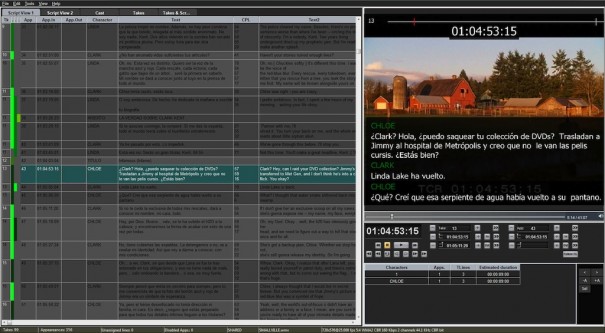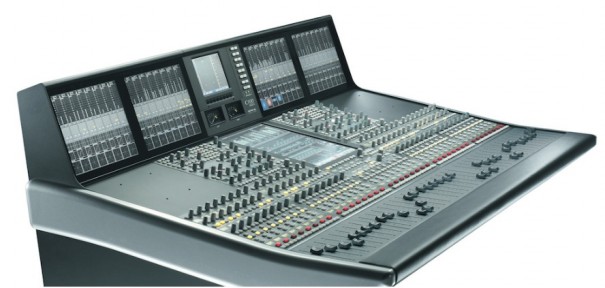Screensound ADR: Solid State Logic lanza la primera solución completa para ADR
Esta solución está diseñada para optimizar y estandarizar ADR (Sustitución de Diálogo Automatizado) para cine, foley (grabación de efectos de sala) y el doblaje a lenguas locales para cine y televisión.
Solid State Logic ha anunciado en IBC 2012 ScreenSound ADR, una solución diseñada para optimizar y estandarizar ADR (Sustitución de Diálogo Automatizado) para cine, foley (grabación de efectos de sala) y el doblaje a lenguas locales para cine y televisión.
ScreenSound ADR es la primera solución mundial, diseñada para ofrecer un flujo de trabajo mas rápido y eficiente en ADR combinando un conjunto de aplicaciones de software integradas que ofrecen alineación de dialogo y preparación de sesión, control de la sesión y administración, y grabación optimizada de audio; con una potente plataforma hardware incluyendo un ordenador anfitrión, I/O y una superficie de control hardware Nucleus. En cada paso del proceso de ADR ScreenSound ADR provee soluciones dedicadas a optimizar la preparación, operación y producción.
ScreenSound ADR se basa en un flujo de trabajo eficiente. La etapa de preparación de sesión se controla por SpotShot, una herramienta para registro de tomas, alineamiento de diálogo, y preparación de sesiones. Los guiones importados son convertidos automáticamente a listas de tomas y una interfaz dedicada optimiza el proceso de alineamiento de diálogo con un reproductor integrado de video de alta definición con guión completo y sobreimpresión de texto de anotaciones. Las listas de tomas pueden ser filtradas para mostrar apariciones individuales de miembros del elenco o de grupos y calcular el conteo de palabras/líneas para ayudar a planear los horarios del estudio y el talento. SpotShot es una aplicación de modo de operación independiente (standalone), que permite hacer alineamiento de diálogo sin estar en el estudio de ADR.
SpotFire, uno de los elementos fundamentales de ScreenSound ADR, ofrece una interfaz dedicada de manejo de sesión y ADR automatizado que otorga control completo sobre el flujo de trabajo en la sesión de estudio. SpotFire ofrece una interfaz única que combina un panel de control basado en “ensaya-graba-revisa” con una lista de tomas versátil y configurable, que hace simple y eficaz ver, navegar y controlar el proceso de grabación. SpotFire usa la DAW Soundscape de SSL, como la plataforma subyacente para grabación, edición y mezcla con todas las funciones de armar canales, transporte y grabación controladas en su totalidad por la interfaz dedicada de ADR de SpotFire. Con ScreenSound ADR el flujo de trabajo en audio se integra con el funcionamiento de la industria hoy en día: El sistema importa sesiones en formatos nativos .ptf de Pro Tools y puede exportar sesiones finalizadas en formato nativo .ptf de Pro Tools. SpotFire también alimenta y controla VisionCue, un poderoso sistema de indicación a artistas (artist cue). VisionCue es un reproductor integrado de video HD multi-pantallas, con desplazamiento de guión, anotación, línea grafica de tiempo de cues (indicaciones) y conteo en plantilla configurable. VisionCue puede reproducir, de manera nativa, un amplio rango de formatos de video llegando hasta Pro Res y Avid dnxhd sin necesidad de conversión de código; el sistema además es compatible con interfaces de video BlackMagic Design.
ScreenSound ADR es un sistema basado en hardware llave en mano. La multi-galardonada superficie de control SSL Nucleus, concede y posibilita control manual excepcionalmente configurable para una operación acelerada (Nucleus también proporciona 2 pre-amplificadores de micrófono SSL SuperAnalogue™). Además, los conversores de audio Alpha-Link de SSL ofrecen opciones de I/O versátiles y escalables para grabar y monitorear con el software de mezcla SSL MX4 suministrando a un mezclador estándar plantillas y una arquitectura abierta de enrutamiento flexible. La garantía de un sistema PC certificado por SSL completa una solución extremo-a-extremo única para acelerar su rendimiento y flujo de trabajo en producción.
Nuevo software para la C100
El nuevo software V5 para la consola digital para broadcast C100 HDS en IBC 2012 se enfoca principalmente en la implementación del Modo Dual de Operación. Desarrollado como respuesta a los comentarios y sugerencias de un amplio rango de clientes SSL, esta actualización es especialmente relevante a instalaciones móviles cuando son necesarios dos operadores para trabajar en producciones complejas, pero donde el peso y el espacio son un lujo escaso.
El Modo Dual de Operación de SSL provee a dos operadores la capacidad de tener controles físicos independientes y acceso a los recursos de audio compartidos, a través de un mecanismo de procesamiento de una sola consola, Routing y configuración entrada/salida (I/O). El sistema permite que un número ilimitado de bahías de ocho canales con faders sean asignadas a un segundo operador. Estas bahías pueden estar situadas en cualquier extremo de la consola C100 o separadas e instaladas en una ubicación remota, como una galería de producción. Las segundas bahías de operación pueden especificarse con un Master Tile dedicado para conseguir acceso a EQ, procesadores de dinámica, envíos auxiliares (sends) y múltiples funciones de ruta; también se puede configurar sin un Master Tile para operación simple de faders.
El Modo Dual de Operación divide el sistema C100 PFL para proporcionar control PFL independiente a cada operador con monitoreo a través de auriculares, o la salida principal o mini de los monitores. Si ambos operadores acceden el sistema PFL de manera simultanea y rutan a las salidas de monitor, el sistema PFL entrega una suma de todos los canales seleccionados. V5 también lanza un nuevo modo momentáneo “non-latching” PFL para facilitar el uso compartido de las salidas de monitor.
Cada operador también tendrá acceso independiente a las capas de usuario (user layers) para facilitar la selección de canales individuales que han de ser establecidas en el área de cada operador y a los canales individuales que son un recurso común, permitiendo el control simultáneo desde ambas áreas de operación. Un sistema completamente redundante C100 verá ambas áreas de los operadores como una única consola, brindando una redundante transparencia a ambos usuarios. Para un “recall” de proyectos simplificado en un sistema dual de operación, todos los ajustes de ambos operadores son también guardados en un solo proyecto.
Did you like this article?
Subscribe to us RSS feed And you will not miss anything.

















